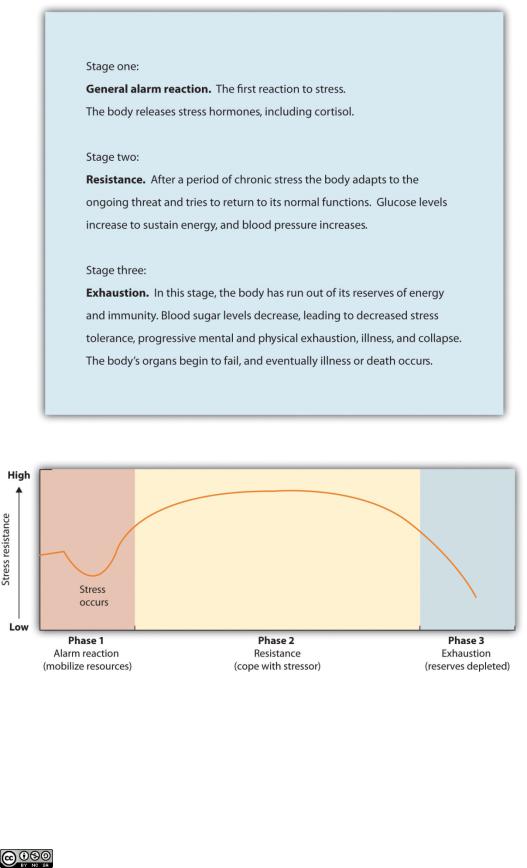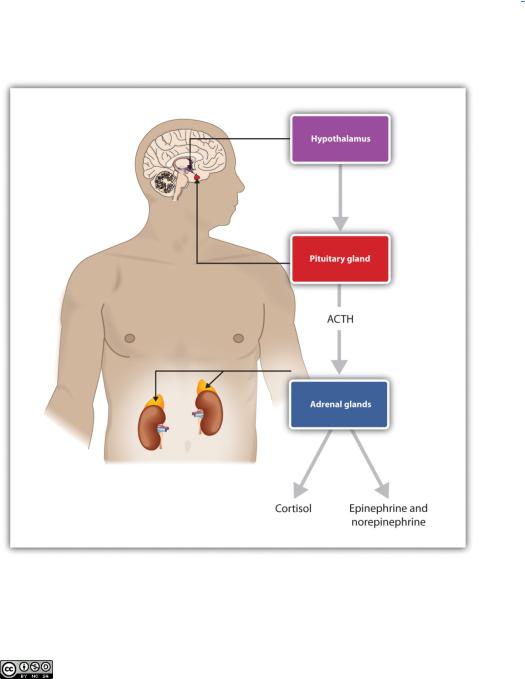
- •Preface
- •Approach and Pedagogy
- •Chapter 1
- •Introducing Psychology
- •1.1 Psychology as a Science
- •The Problem of Intuition
- •Research Focus: Unconscious Preferences for the Letters of Our Own Name
- •Why Psychologists Rely on Empirical Methods
- •Levels of Explanation in Psychology
- •The Challenges of Studying Psychology
- •1.2 The Evolution of Psychology: History, Approaches, and Questions
- •Early Psychologists
- •Structuralism: Introspection and the Awareness of Subjective Experience
- •Functionalism and Evolutionary Psychology
- •Psychodynamic Psychology
- •Behaviorism and the Question of Free Will
- •Research Focus: Do We Have Free Will?
- •The Cognitive Approach and Cognitive Neuroscience
- •The War of the Ghosts
- •Social-Cultural Psychology
- •The Many Disciplines of Psychology
- •Psychology in Everyday Life: How to Effectively Learn and Remember
- •1.3 Chapter Summary
- •Chapter 2
- •Psychological Science
- •Psychological Journals
- •2.1 Psychologists Use the Scientific Method to Guide Their Research
- •The Scientific Method
- •Laws and Theories as Organizing Principles
- •The Research Hypothesis
- •Conducting Ethical Research
- •Characteristics of an Ethical Research Project Using Human Participants
- •Ensuring That Research Is Ethical
- •Research With Animals
- •APA Guidelines on Humane Care and Use of Animals in Research
- •Descriptive Research: Assessing the Current State of Affairs
- •Correlational Research: Seeking Relationships Among Variables
- •Experimental Research: Understanding the Causes of Behavior
- •Research Focus: Video Games and Aggression
- •2.3 You Can Be an Informed Consumer of Psychological Research
- •Threats to the Validity of Research
- •Psychology in Everyday Life: Critically Evaluating the Validity of Websites
- •2.4 Chapter Summary
- •Chapter 3
- •Brains, Bodies, and Behavior
- •Did a Neurological Disorder Cause a Musician to Compose Boléro and an Artist to Paint It 66 Years Later?
- •3.1 The Neuron Is the Building Block of the Nervous System
- •Neurons Communicate Using Electricity and Chemicals
- •Video Clip: The Electrochemical Action of the Neuron
- •Neurotransmitters: The Body’s Chemical Messengers
- •3.2 Our Brains Control Our Thoughts, Feelings, and Behavior
- •The Old Brain: Wired for Survival
- •The Cerebral Cortex Creates Consciousness and Thinking
- •Functions of the Cortex
- •The Brain Is Flexible: Neuroplasticity
- •Research Focus: Identifying the Unique Functions of the Left and Right Hemispheres Using Split-Brain Patients
- •Psychology in Everyday Life: Why Are Some People Left-Handed?
- •3.3 Psychologists Study the Brain Using Many Different Methods
- •Lesions Provide a Picture of What Is Missing
- •Recording Electrical Activity in the Brain
- •Peeking Inside the Brain: Neuroimaging
- •Research Focus: Cyberostracism
- •3.4 Putting It All Together: The Nervous System and the Endocrine System
- •Electrical Control of Behavior: The Nervous System
- •The Body’s Chemicals Help Control Behavior: The Endocrine System
- •3.5 Chapter Summary
- •Chapter 4
- •Sensing and Perceiving
- •Misperception by Those Trained to Accurately Perceive a Threat
- •4.1 We Experience Our World Through Sensation
- •Sensory Thresholds: What Can We Experience?
- •Link
- •Measuring Sensation
- •Research Focus: Influence without Awareness
- •4.2 Seeing
- •The Sensing Eye and the Perceiving Visual Cortex
- •Perceiving Color
- •Perceiving Form
- •Perceiving Depth
- •Perceiving Motion
- •Beta Effect and Phi Phenomenon
- •4.3 Hearing
- •Hearing Loss
- •4.4 Tasting, Smelling, and Touching
- •Tasting
- •Smelling
- •Touching
- •Experiencing Pain
- •4.5 Accuracy and Inaccuracy in Perception
- •How the Perceptual System Interprets the Environment
- •Video Clip: The McGurk Effect
- •Video Clip: Selective Attention
- •Illusions
- •The Important Role of Expectations in Perception
- •Psychology in Everyday Life: How Understanding Sensation and Perception Can Save Lives
- •4.6 Chapter Summary
- •Chapter 5
- •States of Consciousness
- •An Unconscious Killing
- •5.1 Sleeping and Dreaming Revitalize Us for Action
- •Research Focus: Circadian Rhythms Influence the Use of Stereotypes in Social Judgments
- •Sleep Stages: Moving Through the Night
- •Sleep Disorders: Problems in Sleeping
- •The Heavy Costs of Not Sleeping
- •Dreams and Dreaming
- •5.2 Altering Consciousness With Psychoactive Drugs
- •Speeding Up the Brain With Stimulants: Caffeine, Nicotine, Cocaine, and Amphetamines
- •Slowing Down the Brain With Depressants: Alcohol, Barbiturates and Benzodiazepines, and Toxic Inhalants
- •Opioids: Opium, Morphine, Heroin, and Codeine
- •Hallucinogens: Cannabis, Mescaline, and LSD
- •Why We Use Psychoactive Drugs
- •Research Focus: Risk Tolerance Predicts Cigarette Use
- •5.3 Altering Consciousness Without Drugs
- •Changing Behavior Through Suggestion: The Power of Hypnosis
- •Reducing Sensation to Alter Consciousness: Sensory Deprivation
- •Meditation
- •Video Clip: Try Meditation
- •Psychology in Everyday Life: The Need to Escape Everyday Consciousness
- •5.4 Chapter Summary
- •Chapter 6
- •Growing and Developing
- •The Repository for Germinal Choice
- •6.1 Conception and Prenatal Development
- •The Zygote
- •The Embryo
- •The Fetus
- •How the Environment Can Affect the Vulnerable Fetus
- •6.2 Infancy and Childhood: Exploring and Learning
- •The Newborn Arrives With Many Behaviors Intact
- •Research Focus: Using the Habituation Technique to Study What Infants Know
- •Cognitive Development During Childhood
- •Video Clip: Object Permanence
- •Social Development During Childhood
- •Knowing the Self: The Development of the Self-Concept
- •Video Clip: The Harlows’ Monkeys
- •Video Clip: The Strange Situation
- •Research Focus: Using a Longitudinal Research Design to Assess the Stability of Attachment
- •6.3 Adolescence: Developing Independence and Identity
- •Physical Changes in Adolescence
- •Cognitive Development in Adolescence
- •Social Development in Adolescence
- •Developing Moral Reasoning: Kohlberg’s Theory
- •Video Clip: People Being Interviewed About Kohlberg’s Stages
- •6.4 Early and Middle Adulthood: Building Effective Lives
- •Psychology in Everyday Life: What Makes a Good Parent?
- •Physical and Cognitive Changes in Early and Middle Adulthood
- •Menopause
- •Social Changes in Early and Middle Adulthood
- •6.5 Late Adulthood: Aging, Retiring, and Bereavement
- •Cognitive Changes During Aging
- •Dementia and Alzheimer’s Disease
- •Social Changes During Aging: Retiring Effectively
- •Death, Dying, and Bereavement
- •6.6 Chapter Summary
- •Chapter 7
- •Learning
- •My Story of Posttraumatic Stress Disorder
- •7.1 Learning by Association: Classical Conditioning
- •Pavlov Demonstrates Conditioning in Dogs
- •The Persistence and Extinction of Conditioning
- •The Role of Nature in Classical Conditioning
- •How Reinforcement and Punishment Influence Behavior: The Research of Thorndike and Skinner
- •Video Clip: Thorndike’s Puzzle Box
- •Creating Complex Behaviors Through Operant Conditioning
- •7.3 Learning by Insight and Observation
- •Observational Learning: Learning by Watching
- •Video Clip: Bandura Discussing Clips From His Modeling Studies
- •Research Focus: The Effects of Violent Video Games on Aggression
- •7.4 Using the Principles of Learning to Understand Everyday Behavior
- •Using Classical Conditioning in Advertising
- •Video Clip: Television Ads
- •Psychology in Everyday Life: Operant Conditioning in the Classroom
- •Reinforcement in Social Dilemmas
- •7.5 Chapter Summary
- •Chapter 8
- •Remembering and Judging
- •She Was Certain, but She Was Wrong
- •Differences between Brains and Computers
- •Video Clip: Kim Peek
- •8.1 Memories as Types and Stages
- •Explicit Memory
- •Implicit Memory
- •Research Focus: Priming Outside Awareness Influences Behavior
- •Stages of Memory: Sensory, Short-Term, and Long-Term Memory
- •Sensory Memory
- •Short-Term Memory
- •8.2 How We Remember: Cues to Improving Memory
- •Encoding and Storage: How Our Perceptions Become Memories
- •Research Focus: Elaboration and Memory
- •Using the Contributions of Hermann Ebbinghaus to Improve Your Memory
- •Retrieval
- •Retrieval Demonstration
- •States and Capital Cities
- •The Structure of LTM: Categories, Prototypes, and Schemas
- •The Biology of Memory
- •8.3 Accuracy and Inaccuracy in Memory and Cognition
- •Source Monitoring: Did It Really Happen?
- •Schematic Processing: Distortions Based on Expectations
- •Misinformation Effects: How Information That Comes Later Can Distort Memory
- •Overconfidence
- •Heuristic Processing: Availability and Representativeness
- •Salience and Cognitive Accessibility
- •Counterfactual Thinking
- •Psychology in Everyday Life: Cognitive Biases in the Real World
- •8.4 Chapter Summary
- •Chapter 9
- •Intelligence and Language
- •How We Talk (or Do Not Talk) about Intelligence
- •9.1 Defining and Measuring Intelligence
- •General (g) Versus Specific (s) Intelligences
- •Measuring Intelligence: Standardization and the Intelligence Quotient
- •The Biology of Intelligence
- •Is Intelligence Nature or Nurture?
- •Psychology in Everyday Life: Emotional Intelligence
- •9.2 The Social, Cultural, and Political Aspects of Intelligence
- •Extremes of Intelligence: Retardation and Giftedness
- •Extremely Low Intelligence
- •Extremely High Intelligence
- •Sex Differences in Intelligence
- •Racial Differences in Intelligence
- •Research Focus: Stereotype Threat
- •9.3 Communicating With Others: The Development and Use of Language
- •The Components of Language
- •Examples in Which Syntax Is Correct but the Interpretation Can Be Ambiguous
- •The Biology and Development of Language
- •Research Focus: When Can We Best Learn Language? Testing the Critical Period Hypothesis
- •Learning Language
- •How Children Learn Language: Theories of Language Acquisition
- •Bilingualism and Cognitive Development
- •Can Animals Learn Language?
- •Video Clip: Language Recognition in Bonobos
- •Language and Perception
- •9.4 Chapter Summary
- •Chapter 10
- •Emotions and Motivations
- •Captain Sullenberger Conquers His Emotions
- •10.1 The Experience of Emotion
- •Video Clip: The Basic Emotions
- •The Cannon-Bard and James-Lange Theories of Emotion
- •Research Focus: Misattributing Arousal
- •Communicating Emotion
- •10.2 Stress: The Unseen Killer
- •The Negative Effects of Stress
- •Stressors in Our Everyday Lives
- •Responses to Stress
- •Managing Stress
- •Emotion Regulation
- •Research Focus: Emotion Regulation Takes Effort
- •10.3 Positive Emotions: The Power of Happiness
- •Finding Happiness Through Our Connections With Others
- •What Makes Us Happy?
- •10.4 Two Fundamental Human Motivations: Eating and Mating
- •Eating: Healthy Choices Make Healthy Lives
- •Obesity
- •Sex: The Most Important Human Behavior
- •The Experience of Sex
- •The Many Varieties of Sexual Behavior
- •Psychology in Everyday Life: Regulating Emotions to Improve Our Health
- •10.5 Chapter Summary
- •Chapter 11
- •Personality
- •Identical Twins Reunited after 35 Years
- •11.1 Personality and Behavior: Approaches and Measurement
- •Personality as Traits
- •Example of a Trait Measure
- •Situational Influences on Personality
- •The MMPI and Projective Tests
- •Psychology in Everyday Life: Leaders and Leadership
- •11.2 The Origins of Personality
- •Psychodynamic Theories of Personality: The Role of the Unconscious
- •Id, Ego, and Superego
- •Research Focus: How the Fear of Death Causes Aggressive Behavior
- •Strengths and Limitations of Freudian and Neo-Freudian Approaches
- •Focusing on the Self: Humanism and Self-Actualization
- •Research Focus: Self-Discrepancies, Anxiety, and Depression
- •Studying Personality Using Behavioral Genetics
- •Studying Personality Using Molecular Genetics
- •Reviewing the Literature: Is Our Genetics Our Destiny?
- •11.4 Chapter Summary
- •Chapter 12
- •Defining Psychological Disorders
- •When Minor Body Imperfections Lead to Suicide
- •12.1 Psychological Disorder: What Makes a Behavior “Abnormal”?
- •Defining Disorder
- •Psychology in Everyday Life: Combating the Stigma of Abnormal Behavior
- •Diagnosing Disorder: The DSM
- •Diagnosis or Overdiagnosis? ADHD, Autistic Disorder, and Asperger’s Disorder
- •Attention-Deficit/Hyperactivity Disorder (ADHD)
- •Autistic Disorder and Asperger’s Disorder
- •12.2 Anxiety and Dissociative Disorders: Fearing the World Around Us
- •Generalized Anxiety Disorder
- •Panic Disorder
- •Phobias
- •Obsessive-Compulsive Disorders
- •Posttraumatic Stress Disorder (PTSD)
- •Dissociative Disorders: Losing the Self to Avoid Anxiety
- •Dissociative Amnesia and Fugue
- •Dissociative Identity Disorder
- •Explaining Anxiety and Dissociation Disorders
- •12.3 Mood Disorders: Emotions as Illness
- •Behaviors Associated with Depression
- •Dysthymia and Major Depressive Disorder
- •Bipolar Disorder
- •Explaining Mood Disorders
- •Research Focus: Using Molecular Genetics to Unravel the Causes of Depression
- •12.4 Schizophrenia: The Edge of Reality and Consciousness
- •Symptoms of Schizophrenia
- •Explaining Schizophrenia
- •12.5 Personality Disorders
- •Borderline Personality Disorder
- •Research Focus: Affective and Cognitive Deficits in BPD
- •Antisocial Personality Disorder (APD)
- •12.6 Somatoform, Factitious, and Sexual Disorders
- •Somatoform and Factitious Disorders
- •Sexual Disorders
- •Disorders of Sexual Function
- •Paraphilias
- •12.7 Chapter Summary
- •Chapter 13
- •Treating Psychological Disorders
- •Therapy on Four Legs
- •13.1 Reducing Disorder by Confronting It: Psychotherapy
- •DSM-IV-TR Criteria for Diagnosing Attention-Deficit/Hyperactivity Disorder (ADHD)
- •Psychology in Everyday Life: Seeking Treatment for Psychological Difficulties
- •Psychodynamic Therapy
- •Important Characteristics and Experiences in Psychoanalysis
- •Humanistic Therapies
- •Behavioral Aspects of CBT
- •Cognitive Aspects of CBT
- •Combination (Eclectic) Approaches to Therapy
- •13.2 Reducing Disorder Biologically: Drug and Brain Therapy
- •Drug Therapies
- •Using Stimulants to Treat ADHD
- •Antidepressant Medications
- •Antianxiety Medications
- •Antipsychotic Medications
- •Direct Brain Intervention Therapies
- •13.3 Reducing Disorder by Changing the Social Situation
- •Group, Couples, and Family Therapy
- •Self-Help Groups
- •Community Mental Health: Service and Prevention
- •Some Risk Factors for Psychological Disorders
- •Research Focus: The Implicit Association Test as a Behavioral Marker for Suicide
- •13.4 Evaluating Treatment and Prevention: What Works?
- •Effectiveness of Psychological Therapy
- •Research Focus: Meta-Analyzing Clinical Outcomes
- •Effectiveness of Biomedical Therapies
- •Effectiveness of Social-Community Approaches
- •13.5 Chapter Summary
- •Chapter 14
- •Psychology in Our Social Lives
- •Binge Drinking and the Death of a Homecoming Queen
- •14.1 Social Cognition: Making Sense of Ourselvesand Others
- •Perceiving Others
- •Forming Judgments on the Basis of Appearance: Stereotyping, Prejudice, and Discrimination
- •Implicit Association Test
- •Research Focus: Forming Judgments of People in Seconds
- •Close Relationships
- •Causal Attribution: Forming Judgments by Observing Behavior
- •Attitudes and Behavior
- •14.2 Interacting With Others: Helping, Hurting, and Conforming
- •Helping Others: Altruism Helps Create Harmonious Relationships
- •Why Are We Altruistic?
- •How the Presence of Others Can Reduce Helping
- •Video Clip: The Case of Kitty Genovese
- •Human Aggression: An Adaptive yet Potentially Damaging Behavior
- •The Ability to Aggress Is Part of Human Nature
- •Negative Experiences Increase Aggression
- •Viewing Violent Media Increases Aggression
- •Video Clip
- •Research Focus: The Culture of Honor
- •Conformity and Obedience: How Social Influence Creates Social Norms
- •Video Clip
- •Do We Always Conform?
- •14.3 Working With Others: The Costs and Benefits of Social Groups
- •Working in Front of Others: Social Facilitation and Social Inhibition
- •Working Together in Groups
- •Psychology in Everyday Life: Do Juries Make Good Decisions?
- •Using Groups Effectively
- •14.4 Chapter Summary

following the disaster, and this is probably due to the stress that the hurricane created (American Medical Association, 2009). [2] And people in New York City who lived nearer to the site of the 9/11 terrorist attacks reported experiencing more stress in the year following it than those who lived farther away (Pulcino et al., 2003). [3] But stress is not unique to the experience of extremely traumatic events. It can also occur, and have a variety of negative outcomes, in our everyday lives.
The Negative Effects of Stress
The physiologist Hans Seyle (1907–1982) studied stress by examining how rats responded to being exposed to stressors such as extreme cold, infection, shock, or excessive exercise (Seyle, 1936, 1974, 1982). [4] Seyle found that regardless of the source of the stress, the rats experienced the same series of physiological changes as they suffered the prolonged stress. Seyle created the termgeneral adaptation syndrome to refer to the three distinct phases of physiological change that occur in response to long-term stress: alarm, resistance, and exhaustion (Figure 10.8 "General Adaptation Syndrome").
Saylor URL: http://www.saylor.org/books |
Saylor.org |
|
490 |

Figure 10.8 General Adaptation Syndrome
Hans Seyle’s research on the general adaptation syndrome documented the stages of prolonged exposure to stress.
Saylor URL: http://www.saylor.org/books |
Saylor.org |
|
491 |

The experience of stress creates both an increase in general arousal in the sympathetic division of the autonomic nervous system (ANS), as well as another, even more complex, system of physiological changes through the HPA axis ((Reference None not found in Book)).
The HPA axis is a physiological response to stress involving interactions among the hypothalamus, the pituitary, and the adrenal glands. The HPA response begins when the hypothalamus secretes releasing hormones that direct the pituitary gland to release the hormone ACTH. ACTH then directs the adrenal glands to secrete more hormones, including epinephrine, norepinephrine, and cortisol, a stress hormone that releases sugars into the blood, helping preparing the body to respond to threat (Rodrigues, LeDoux, & Sapolsky, 2009). [5]
Figure 10.9 HPA Axis
Stress activates the HPA axis. The result is the secretion of epinephrine, norepinephrine, and cortisol.
Saylor URL: http://www.saylor.org/books |
Saylor.org |
|
492 |

The initial arousal that accompanies stress is normally quite adaptive because it helps us respond to potentially dangerous events. The experience of prolonged stress, however, has a direct negative influence on our physical health, because at the same time that stress increases activity in the sympathetic division of the ANS, it also suppresses activity in the parasympathetic division of the ANS. When stress is long-term, the HPA axis remains active and the adrenals continue to produce cortisol. This increased cortisol production exhausts the stress mechanism, leading to fatigue and depression.
The HPA reactions to persistent stress lead to a weakening of the immune system, making us more susceptible to a variety of health problems including colds and other diseases (Cohen & Herbert, 1996; Faulkner & Smith, 2009; Miller, Chen, & Cole, 2009; Uchino, Smith, HoltLunstad, Campo, & Reblin, 2007). [6] Stress also damages our DNA, making us less likely to be able to repair wounds and respond to the genetic mutations that cause disease (Epel et al., 2006). [7] As a result, wounds heal more slowly when we are under stress, and we are more likely
to get cancer (Kiecolt-Glaser, McGuire, Robles, & Glaser, 2002; Wells, 2006). [8]
Chronic stress is also a major contributor to heart disease. Although heart disease is caused in part by genetic factors, as well as high blood pressure, high cholesterol, and cigarette smoking, it is also caused by stress (Krantz & McCeney, 2002). [9] Long-term stress creates two opposite effects on the coronary system. Stress increases cardiac output (i.e., the heart pumps more blood) at the same time that it reduces the ability of the blood vessels to conduct blood through the arteries, as the increase in levels of cortisol leads to a buildup of plaque on artery walls (Dekker et al., 2008). [10] The combination of increased blood flow and arterial constriction leads to increased blood pressure (hypertension), which can damage the heart muscle, leading to heart attack and death.
Stressors in Our Everyday Lives
The stressors for Seyle’s rats included electric shock and exposure to cold. Although these are probably not on your top-10 list of most common stressors, the stress that you experience in your everyday life can also be taxing. Thomas Holmes and Richard Rahe (1967) [11] developed a measure of some everyday life events that might lead to stress, and you can assess your own
Saylor URL: http://www.saylor.org/books |
Saylor.org |
|
493 |

likely stress level by completing the measure in Table 10.2 "The Holmes and Rahe Stress Scale". You might want to pay particular attention to this score, because it can predict the likelihood that you will get sick. Rahe and colleagues (1970) [12]asked 2,500 members of the military to complete the rating scale and then assessed the health records of the soldiers over the following 6 months. The results were clear: The higher the scale score, the more likely the soldier was to end up in the hospital.
Table 10.2 The Holmes and Rahe Stress Scale
Life event |
Score |
|
|
Death of spouse |
100 |
|
|
Divorce |
73 |
|
|
Marital separation from mate |
65 |
|
|
Detention in jail, other institution |
63 |
|
|
Death of a close family member |
63 |
|
|
Major personal injury or illness |
53 |
|
|
Marriage |
50 |
|
|
Fired from work |
47 |
|
|
Marital reconciliation |
45 |
|
|
Retirement |
45 |
|
|
Major change in the health or behavior of a family member |
44 |
|
|
Pregnancy |
40 |
|
|
Sexual difficulties |
39 |
|
|
Gaining a new family member (e.g., through birth, adoption, oldster moving, etc.) |
39 |
|
|
Major business readjustment (e.g., merger, reorganization, bankruptcy) |
39 |
|
|
Major change in financial status |
38 |
|
|
Death of close friend |
37 |
|
|
Change to different line of work |
36 |
|
|
Major change in the number of arguments with spouse |
35 |
|
|
Saylor URL: http://www.saylor.org/books |
Saylor.org |
|
494 |

Life event |
Score |
|
|
|
|
Taking out a mortgage or loan for a major purchase |
31 |
|
|
|
|
Foreclosure on a mortgage or loan |
30 |
|
|
|
|
Major change in responsibilities at work |
29 |
|
|
|
|
Son or daughter leaving home (e.g., marriage, attending college) |
29 |
|
|
|
|
Trouble with in-laws |
29 |
|
|
|
|
Outstanding personal achievement |
28 |
|
|
|
|
Spouse beginning or ceasing to work outside the home |
26 |
|
|
|
|
Beginning or ceasing formal schooling |
26 |
|
|
|
|
Major change in living conditions |
25 |
|
|
|
|
Revision of personal habits (dress, manners, associations, etc.) |
24 |
|
|
|
|
Trouble with boss |
23 |
|
|
|
|
Major change in working hours or conditions |
20 |
|
|
|
|
Change in residence |
20 |
|
|
|
|
Change to a new school |
20 |
|
|
|
|
Major change in usual type and/or amount of recreation |
19 |
|
|
|
|
Major change in church activities (a lot more or less than usual) |
19 |
|
|
|
|
Major change in social activities (clubs, dancing, movies, visiting) |
18 |
|
|
|
|
Taking out a mortgage or loan for a lesser purchase (e.g., for a car, television , freezer, etc.) |
17 |
|
|
|
|
Major change in sleeping habits |
16 |
|
|
|
|
Major change in the number of family get-togethers |
15 |
|
|
|
|
Major change in eating habits |
15 |
|
|
|
|
Vacation |
13 |
|
|
|
|
Christmas season |
12 |
|
|
|
|
Minor violations of the law (e.g., traffic tickets, etc.) |
11 |
|
|
|
|
Total |
______ |
|
|
|
Saylor URL: http://www.saylor.org/books |
Saylor.org |
|
495 |
